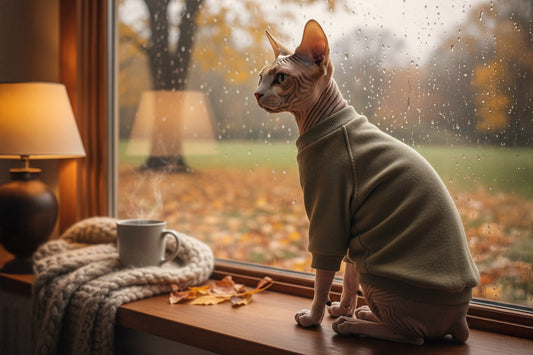As a loving cat parent, you know that your feline friend is more than just a pet – they're family. Whether you're planning a summer adventure, a move, or even just a trip to the vet, ensuring your cat's comfort and safety during travel is paramount. And for those moments outside the carrier, like exploring a new park or enjoying a supervised stroll, a well-fitting harness is just as crucial. Check out our handmade cat harnesses designed specifically for your cat's comfort and style!
Choosing the right cat carrier can be a daunting task with so many options available. This guide will break down the different types of carriers – backpacks, soft carriers, and hard carriers – highlighting their pros and cons, especially for summer travel and air journeys.

Why a Cat Carrier is a Must-Have
Before diving into specific types, let's briefly touch upon why a reliable cat carrier is indispensable:
-
Safety: Protects your cat from injury during car rides, public transport, or accidental escapes.
-
Security: Provides a sense of security and a safe "den" for your cat in unfamiliar environments.
-
Compliance: Many airlines, trains, and even some hotels require pets to be in carriers.
-
Convenience: Makes it easier to transport your cat, whether to the vet, a friend's house, or on a grand adventure.
1. Backpack Cat Carriers: For the Adventurous Cat Parent
Backpack carriers have gained immense popularity, especially among those who love to hike, bike, or simply want a hands-free way to transport their feline companion.
Pros of Backpack Carriers (General):
-
Hands-Free: Allows you to carry your cat comfortably while keeping your hands free for other tasks.
-
Mobility: Great for walking, hiking, or navigating crowded areas.
-
Engagement: Some designs allow your cat to see their surroundings, which can be enriching for curious felines.
Cons of Backpack Carriers (General):
-
Space Limitations: Can be restrictive for larger cats or long journeys, limiting their ability to stretch or change positions.
-
Ventilation Varies: Some models may lack adequate airflow, especially in warmer weather.
-
Stability: Less stable than a hard carrier when placed on the ground.
-
Ibiyaya Ultralight Pro Backpack (from Johndog.pl): This sleek and lightweight option provides good ventilation and is designed for comfortable carrying, making it a great choice for day trips or shorter excursions.

-
Pros: Lightweight and comfortable for the human to carry, good ventilation with mesh windows, stylish design.
-
Cons: Might be a bit small for very large cats, less robust protection compared to a hard carrier.
-
-
PETKIT Cat Backpack Carrier (Amazon): This backpack often features unique designs like built-in fans for ventilation and observation windows, aiming to enhance your cat's comfort and your peace of mind.

-
Pros: Often includes a small fan for air circulation (excellent for summer!), observation window allows your cat to see out, relatively spacious for a backpack, comfortable for the carrier with padded straps.
-
Cons: Can be bulkier than other backpacks, requires batteries for the fan, the observation window might not be comfortable for all cats if they prefer more privacy.
-
-
Avoid fully transparent "bubble" backpack carriers with a full transparent wall.

While visually appealing to humans, these can be extremely uncomfortable and stressful for cats. Cats instinctually seek enclosed spaces for security. A fully transparent wall offers no hiding spot, leaving your cat feeling exposed and vulnerable, especially in unfamiliar or busy environments. Always prioritize your cat's comfort and sense of security over aesthetics.
-
-
Pros: Visually interesting for humans, cat can see everything.
-
Cons: Extremely stressful for cats due to lack of privacy and hiding spots, can overheat easily in direct sun, limited ventilation in some designs.
-
2. Soft-Sided Cat Carriers: Versatility and Comfort
Soft-sided carriers are a popular choice for their flexibility, collapsibility, and often lighter weight, making them excellent for car travel and many airline cabins.
Pros of Soft-Sided Carriers (General):
-
Flexible: Can often be compressed slightly to fit under airline seats.
-
Comfortable: Many have soft bedding and good ventilation.
-
Storage: Most are foldable, making storage easy when not in use.
Cons of Soft-Sided Carriers (General):
-
Less Protection: Offers less protection than hard carriers against impacts.
-
Durability: Can be more susceptible to wear and tear from scratching or chewing.
Examples:
-
Sleepypod Air: The Sleepypod Air is renowned for its airline compatibility and safety features. Its innovative design allows it to compress to fit under most airline seats while maintaining structural integrity. It's an investment in your cat's safety and comfort during air travel.

-
Pros: This carrier stands out for its exceptional crash-tested safety, adjustable dimensions that meet most airline in-cabin requirements, superior pet comfort with plush, washable bedding, durable, high-quality construction, and smart features like a trolley pocket and privacy panel for stress-free travel.
-
Cons: Despite its many advantages, the Sleepypod Air's main drawbacks are its high price point, potential for being cramped for very large cats, a possible initial factory odor, and some users finding the zipper access somewhat awkward.
-
BAGLHER Pet Carrier Airline Approved Expandable Foldable: This expandable carrier offers extra space for your cat to move around when stationary, which is a great feature for longer waits or in hotel rooms. Its airline-approved design makes it a versatile choice for various travel scenarios.

-
Pros: Expandable sides offer more space when stationary, good ventilation, foldable for easy storage, generally budget-friendly, airline-approved dimensions.
-
Cons: Expanded sections may not be usable during flight, material durability can vary.
3. Hard-Sided Cat Carriers: Durability and Security
Hard carriers are the traditional choice and are often favored for their robust construction, making them very secure for car travel and for vet visits.
Pros of Hard-Sided Carriers (General):
-
Durable: Extremely sturdy and provide excellent protection against impacts.
-
Easy to Clean: Plastic surfaces are generally easy to wipe down and disinfect.
-
Ventilation: Most have ample ventilation holes.
-
Security: Less likely to be chewed through or clawed open, offering a strong enclosure.
Cons of Hard-Sided Carriers (General):
-
Bulky: Can be cumbersome to carry and store.
-
Less Flexible: Cannot be compressed for tight spaces, making them less suitable for in-cabin air travel.
-
Weight: Generally heavier than soft-sided or backpack carriers.
Examples:
-
Whisker City 2-Door Pet Carrier (from PetSmart): The two-door design is a huge plus! It allows for easier loading and unloading of your cat, especially if they are reluctant to enter through a front door. The hard plastic offers good protection and is easy to clean.

-
Pros: Very durable and protective, easy to clean, two-door access simplifies loading and unloading, good airflow.
-
Cons: Bulky and heavy, not suitable for in-cabin airline travel, less comfortable for the cat compared to carriers with soft interiors.
-
Trixie Transporter Capri 2 XS-S (from Zoowilczek.pl): This is a basic, yet functional, hard-sided carrier often used for short trips like vet visits. Its simple design makes it a reliable choice for general transport needs.

-
Pros: Very affordable, lightweight for a hard carrier, easy to clean, good ventilation with slits on all sides.
-
Cons: Only one front opening, which can make loading a reluctant cat harder; less secure latching mechanism than some premium models; basic features with no added comfort elements.
Choosing the Right Carrier for Summer and Air Travel
Summer Travel Considerations:
-
Ventilation is Key: Regardless of the type, ensure the carrier has excellent airflow to prevent overheating. Look for ample mesh windows or ventilation holes.
-
Light Colors: Lighter-colored carriers absorb less heat than dark ones, which can be beneficial in sunny conditions.
-
Hydration: Always carry water and a collapsible bowl. Consider a carrier that allows for a small water dish to be attached inside.
-
Shade: Never leave your cat in a carrier in direct sunlight, even for a short period.
Air Travel Considerations:
-
Airline Regulations: This is paramount! Every airline has specific requirements for pet carriers (size, dimensions, ventilation, materials). Always check your chosen airline's pet policy well in advance of booking your flight.
-
Under-Seat vs. Cargo: Most airlines allow small cats to travel in the cabin under the seat in front of you (in a soft-sided carrier). Larger cats or those needing more space will need to travel as cargo (usually in a hard-sided carrier meeting IATA standards).
-
Identification: Label your carrier clearly with your name, contact information, and your cat's name.
-
Comfort: Line the carrier with absorbent material and a familiar blanket or toy to help reduce stress.
Final Thoughts on Your Cat's Journey
Investing in a high-quality carrier is investing in your cat's safety and well-being. Consider your cat's personality, size, and your typical travel needs when making your decision. Remember to acclimate your cat to their carrier gradually before any trip. Leave it open with treats and toys inside, making it a positive and familiar space.
Happy travels with your beloved feline!
Planning more adventures with your cat? Don't miss these helpful articles from our blog:



